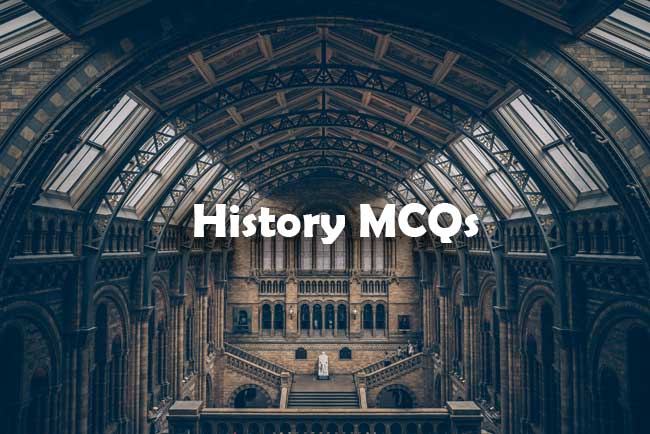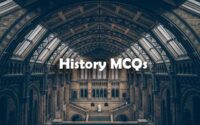SSC CHSL History Questions and Answers
Aspirants can find the SSC CHSL History Previous Year Question Paper with answers here. Staff Selection Commission CHSL History Question Paper are available here. The Candidate who is appearing for Staff Selection Commission CHSL can download the History Paper from the link given.

Also, refer the SSC Combined Higher Secondary Level Examination History Syllabus and Test Patter from the link given. Applicants can download the History Syllabus Pdf for free of cost from the link. However, hope our history material will help you in your preparation.
Furthermore, check the Updated Staff Selection Commission Combined Higher Secondary Level Examination History Syllabus from the link below. Also, download the SSC Combined Higher Secondary Level Examination History Syllabus Pdf. The applied candidates can also allow downloading the SSC CHSL Exam History Model Question Papers from our website.
Questions and Answers on History for SSC CHSL Exam
1. In the Bahmani period, the port of Dabhol was known as……………………
(A) Mustafabad
(B) Nasratpur
(C) Bandar Mubarak
(D) Islamabad
2. Light artillery carried on camel back was called…………………….in Mughal times.
(A) Narnal
(B) Gajal
(C) Arraba
(D) Shutrnal
3. Where is Aurangzeb’s tomb ?
(A) Delhi
(B) Agra
(C) Khuldabad
(D) Daulatabad
4. The Sufi saint Muhammad Banda Nawaz is better known as……………
(A) Baba Farid
(B) Gesudaraz
(C) Baba Palangposh
(D) Shaikh Mohammad
5. Who assumed office as the first viceroy of Portuguese territory of Goa from 1505-1509 ?
(A) Afonso d’Albuquerque
(B) Francisco de Almeida
(C) Vasco da Gama
(D) Father Stevens
6. An early Dutch traveler to India and Indonesia was…………………………
(A) Francisco Pelsaert
(B) Peter Floris
(C) Adrian van Rheede
(D) John Huyghen van Linschoten
7. The cities of Sultanpur and Bandar Mubarak are better known as………. and ……………..
(A) Madurai and Nagapattinam
(B) Dwarasamudra and Kalyani
(C) Chaul and Vengurla
(D) Warangal and Surat
8. Tavernier in the 17th century described two routes from Surat to Agra, one via……………… and the other via……………………
(A) Burhanpur and Ahmedabad
(B) Burhanpur and Sironj
(C) Merta and Kota
(D) Gwalior and Kota
9. In the 16th and 17th centuries, what feature did the ports of Gandevi, Chaul and Narsapur share ?
(A) They were all on the west coast of India
(B) They were all centres of ship building
(C) They were all under the control of the Portuguese
(D) They were all centres of Armenian merchants
10. The Takht-i-Kirmani, a gate built by descendants of a saint from Kirman, is located in………………………..
(A) Chaul
(B) Vengurla
(C) Bidar
(D) Nagpur
11. The segmentary state model was based on the study of……………. by……………..
(A) Chola state, Burton Stein
(B) Alur society, Aidan Southall
(C) Rajput lineages, Richard Fox
(D) Vijayanagar state, N. Karashima
12. The Ragamala paintings are typical of the………………… style of the 18th century.
(A) Deccan
(B) Kangra
(C) Rajput
(D) Pahari
13. Who says that ‘Plassey was a transaction in which the rich bankers of Bengal and Mir Jafar sold out the Nawab to the English ?
(A) N.K. Sinha
(B) K.M. Pannikar
(C) R.S. Sharma
(D) N.L. Chatterjee
14. The Jagat Seths were an influential ……………………. family in Bengal.
(A) Noble
(B) Banking
(C) Military
(D) Physician
15. Mir Jafar shifted his capital from Murshidabad to……………………….
(A) Monghyr
(B) Midnapur
(C) Burdwan
(D) Lakhnauti
16. Where did the British start the Dual system of Government ?
(A) Madras
(B) Bengal
(C) Bombay
(D) Pondicherry
17. Who among the following is known as the ‘liberator of Indian Press’ ?
(A) Lord William Bentinck
(B) Charles Metcalfe
(C) Lord Macaulay
(D) Lord Dalhousie
18. The Lancashire cotton textiles were first introduced in India, in…………….
(A) 1786
(B) 1815
(C) 1831
(D) 1852
19. A modern Western Painting School was established in Pune in 1798. Its student, who famously made the drawings of Ellora as he accompanied Sir Charles Malet in his artistic expedition was………………
(A) Erloo Bin Narayan
(B) Dhakji Dadaji
(C) Gangaram Tambat
(D) Vasudev Kamat
20. Witnessing the devastation of the Indian textile industries, William Bentinck remarked, ‘‘The bones of the……………………..are bleaching the plains of India’’.
(A) Cotton Traders
(B) Cotton Weavers
(C) Mill Workers
(D) Cotton Farmers
|
More History Questions for Preparation
|
|
| UPSC | TNPSC |
| GPSC | WBCS |
| NDA | SSC CHSL |
| DSSB | SSC CGL |
| AFCAT | MTS |
| RRB NTPC | MPSC |
| MPPSC | CDS |
| BPSC | |
21. Tinkathiya system is associated with……………………….cultivation.
(A) Wheat
(B) Cotton
(C) Sugarcane
(D) Indigo
22. This person led a revolt against the moneylenders and the British in Ahmednagar and Nasik region. The British had declared a Prize of Rs. 5,000 to capture him.
(A) Fond Sawant
(B) Narsappa
(C) Shivkar Bapuji Talapade
(D) Raghoji Bhangre
23. Around 1840-41, this freedom fighter had conquered the fort of Badami with the help of other soldiers and hoisted the flag of the Chhatrapati of Satara on this fort.
(A) Sevaram Bhill
(B) Narsingrao Petkar
(C) Umaji Naik
(D) Lahuji Salve
24. This person belonged to the first batch of doctors that graduated from the Grant Medical College in 1850 and was a great patron of arts and theatre.
(A) Bhau Daji Lad
(B) Vishram Ramji Ghole
(C) R.G. Bhandarkar
(D) Jagannath Shankarsheth
25. Who among the following criticised the University Act of 1904. commenting that the Indian Universities had become some of the world’s most governmental institutions ?
(A) Hunter Commission
(B) Sadler Commission
(C) Radhakrishnan Commission
(D) Kothari Commission
26. ……………………..was one of the founders of the Veda Samaj which was founded in 1864.
(A) Shreedharalu Naidu
(B) Dayanand
(C) Dadoba Pandurang
(D) Mahatma Phule
27. In his work ‘‘Tafsir ul Quran— Commentaries on the Quran’’, this reformer argued that the Word of God should be interpreted through the work of God which is open for all to see.
(A) Rashid Ahmed Gangohi
(B) Syed Ahmed Khan
(C) Mahmud ul Hasan
(D) Syed Ahmed Barelvi
28. ……………………was a founder member of the ‘Goa Youth League’.
(A) Beatris de Menzes Braganza
(B) Mohan Ranade
(C) Dayanand Bandodkar
(D) Pandit Nehru
29. Within Imperialistic ideology, the ‘‘policy of assimilation’’ is based on :
(A) The idea that colonizers can be enriched when adapting to the native culture of an area
(B) The idea that local people deserved the right to maintain their native culture
(C) The idea that native populations know what is best for survival in that area
(D) The idea that local people would eventually be absorbed into the colonizers’ culture
30. What is the meaning of the title of Tilak’s book ‘Orion’ ?
(A) Name of a Constellation
(B) Aryan Invasion
(C) Vedic Sweetmeat
(D) A Vedic Deity
31. Members of the States Reorganisation Commission included a jurist, S. Fazl Ali, a Social Worker, H.N. Kunzru and a Historian…………………….
(A) Jawaharlal Nehru
(B) N.V. Gadgil
(C) K.M. Panikkar
(D) R.C. Mujumdar
32. Servants of India Society, All India Women’s Conference and the Indian History Congress were all founded in this city :
(A) Poona
(B) Bombay
(C) Calcutta
(D) Delhi
33. This anthropologist is the author of Maharashtra Sanskruti, which deals with the culture of Maharashtra :
(A) Durga Bhagwat
(B) G.S. Ghurye
(C) Irawati Karve
(D) Gunther Sontheimer
34. The task of allotting 2,50,000 refugees with cultivable land was completed by……………………. Director General of Rehabilitation by 1949.
(A) Sardar Tarlok Singh
(B) Vijayalaxmi Pandit
(C) Sardar Baldev Singh
(D) Sarojini Naidu
35. Sardar Vallabhbhai Patel was compared to…………………..
(A) Mazzini
(B) Bismarck
(C) Lenin
(D) Leo Tolstoy
36. Who is the author of ‘Steamboats on the Indus’ ?
(A) Clive Dewey
(B) Michael Adas
(C) John Hobson
(D) Dharampal
37. How many stages did Immanuel Wallerstein identify in his World Systems theory ?
(A) Two
(B) Three
(C) Four
(D) Five
38. In art history, ……………… is seen as being at the forefront of nationalist responses to colonial interpretations.
(A) Rajendralala Mitra
(B) JDM Beglar
(C) Ram Raz
(D) Ananda K. Coomaraswamy
39. The concept of ‘Total History’ is associated with which one of the following schools of historical writing ?
(A) Marxist School
(B) Positivist School
(C) Annales School
(D) Subaltern School
40. According to Church historiography, what is a chronicle ?
(A) A biography of a great man
(B) A biography of a saint
(C) An account of the rise of the Church
(D) A detailed account of events in a particular place and time
| Ancient India | Modern India |
| Medieval India | World History |
41. The most significant pottery associated with the Indo-Roman Trade is ……………………. .
(A) Amphorae
(B) Bowl
(C) Plate
(D) Jar
42. The Archaeological excavations at Nevasa was carried out by ………………. .
(A) A. Ghosh
(B) B. B. Lal
(C) H.D. Sankalia
(D) Debla Mitra
43. Iron implements were mostly used in which of the following culture of ancient India ?
(A) Mesolithic
(B) Neolithic
(C) Megalithic
(D) Palaeolithic
44. Which of the following excavated sites is an important medieval site of Maharashtra ?
(A) Sanjan
(B) Budhihal
(C) Daulatabad
(D) Morgaon
45. Which of the following kings used the epithet ‘Priyadarshi’ ?
(A) Rudradaman
(B) Chandragupta-II
(C) Ashoka
(D) Gautamiputra Satakarni
46. Which of the following kings was not a Kushana ruler ?
(A) Kanishka-I
(B) Vasudev-I
(C) Chashtana
(D) Huvishka-I
47. Saka Era commenced in …………………. .
(A) 78 C.E.
(B) 57 C.E.
(C) 101 C.E.
(D) 87 C.E.
48. According to Puranas how many kings of the Satavahana dynasty ruled for 460 years ?
(A) 28
(B) 30
(C) 27
(D) 39
49. Which among the following sites does not have rock-cut caves excavated during the Satavahana-Kshatrapa times ?
(A) Bhaje
(B) Pitalkhora
(C) Ellora
(D) Junnar
50. Which among the following Paramara rulers wrote a treatise on Shilpashastra entitled ‘Samarangana Sutradhara’ ?
(A) Udayaditya
(B) Bhoja
(C) Sindhuraja
(D) Lakshmadeva

